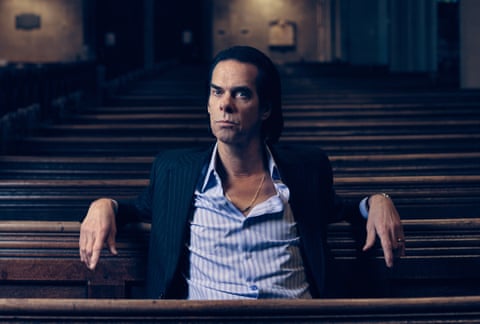Nick Cave has a touch of Dr Frankenstein about him – long, white lab coat, inscrutable smile, unnerving intensity. He introduces me to his two assistants, the identical twins Liv and Dom Cave-Sutherland, who are helping to glaze his ceramics series, The Devil – A Life. The twins are not related to Cave. His wife, the fashion designer Susie Cave, came across them one day, discovered they were ceramicists and thought they would be able to help him complete his project. It adds to the eeriness of it all.
Cave, 66, is one of the world’s great singer-songwriters – from the howling post-punk of the Birthday Party and the Bad Seeds to the lugubrious lyricism of his love songs (Into My Arms, Straight to You and a million others I adore) and the haunted grief of recent albums such as Skeleton Tree, Ghosteen and Carnage. He is also a fine author (see his apocalyptic novel And the Ass Saw the Angel), thinker (his book of conversations with the Observer journalist Sean O’Hagan, Faith, Hope and Carnage), agony uncle (at his website, the Red Hand Files), screenwriter (The Proposition) and now visual artist. Which is where he started out half a century ago.
Cave studied art in Melbourne in the mid-70s before being chucked off his degree course. He reckons he was too fascinated by the subject for his own good. He spent all his time talking about art to the older students and didn’t find the hours to do the actual work. Now, he is making up for lost time.
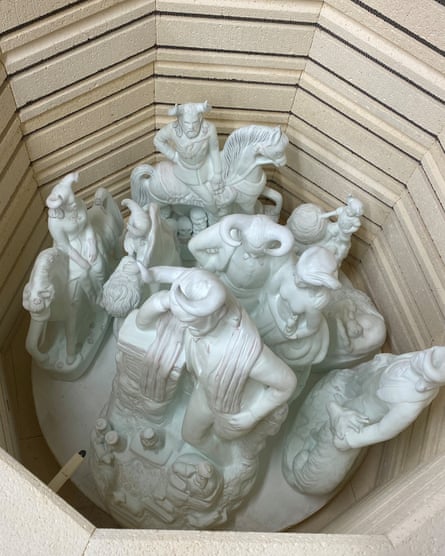

‘These losses are incorporated into the artistic flow’ … Cave’s sculptures go through the glazing process. Photograph: courtesy of Liv & Dom
We are at the headquarters of Susie’s business, where she makes and stores the beautiful dresses she designs as The Vampire’s Wife. For now, it’s doubling as Cave’s studio. He gives me a tour of the 17 ceramic figurines, which will be exhibited at Xavier Hufkens in Brussels next month. The pieces are stunning in a creepy, Cave-esque way, all blood-curdling pastoral idylls. But it’s as a series that they are most powerful. The sculptures, inspired by Staffordshire “flatback” ceramics from the Victorian era, forge a shocking and deeply personal narrative.
Initially, we see the devil as a child – a cute little lad, dimple-cheeked in a white jumpsuit sitting next to a red monkey. “Look at his little face,” Cave says, lovingly. We see the devil getting up to erotic mischief with a sailor, then ecstatic with his first love. “I’m extremely happy with this one,” Cave says. “His impish pleasure and her just drained of life.”
We see the devil going to war in a field of flowers, wading through a field of blood and skulls on his return, getting married. Then the series takes a traumatic turn. “This is The Devil Kills His First Child,” Cave says. “It’s a little Isaac and Abraham thing. Then he’s separated from the world. Life goes on. Then he dances for the last time.” And now we are at the final piece. “He bleeds to death. He’s found washed up and the child is forgiving him, leaning out to him with his hand.”
It’s impossible to know how to respond when Cave reaches the story’s conclusion other than to gulp or weep. After all, this is a man who has lost two sons over the past nine years. In 2015, 15-year-old Arthur died after taking LSD for the first time and falling from a cliff near his home in Brighton. In 2022, 31-year-old Jethro, who had schizophrenia, died in Melbourne. Death and grief have informed all of Cave’s work since Arthur died. But this takes it to another level.

‘The child is forgiving him’ … Devil Bleeds to Death, the final piece in the collection. Photograph: courtesy of Liv & Dom
We say goodbye to the Cave twins, who continue painting pubic hair in gold lustre on the devil’s first love. “We’ll see you, guys! Slave away, my children!” Cave says.
Liv smiles.
“I’m already dressed like a Victorian child’,” Dom says.
“A pint of stout for lunch!” Cave says.
We move into Susie’s office to chat. It’s dark, gothic, a dream home for bats. He whips off his lab coat to reveal an immaculate three-piece suit and sits behind the desk. Before I sit down, I ask if I can do something I have wanted to do for the best part of a decade. I reach over the desk and clumsily hug him.
“Aaah, man! Here, let me stand up.” The last time we talked was 16 years ago. He was making a video that featured Arthur and his twin brother, Earl, who were then seven, gorgeous and already musical (Arthur was playing drums, Earl guitar).
Cave became famous as one of the bad boys of rock – a ghoulish junkie with a feral live act, equally fixated by the Bible and Beelzebub. But he is one of the nicest people I have met. In 2008, I turned up knowing sod all about him. I tell him that he was so generous with his time and nonjudgmental about my ignorance. “Really?” he says, surprised. “That’s good to know. I tend to have a low opinion of myself back then. I see a cutoff point around the death of my first son of a change of character. But it’s not as black and white as I thought.”
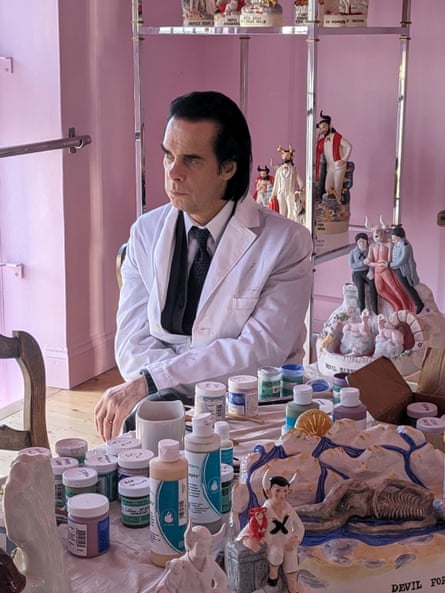
In the studio. Photograph: courtesy of Liv & Dom
Every Cave story seems to begin with a death. Take the origin of the figurines. He went into the studio to start work on them the day his mother, Dawn, died. He had planned to start on that date – 15 September 2020 – for a while. “Susie made me go. She said: ‘Get there and do your work.’” He adored Dawn – she had always stood by him, no matter what trouble he was in. (The day his father died in a car crash, she was called to the police station to bail out 19-year-old Cave after he had been charged with burglary.)
Did he have any idea what he wanted to create in the studio? No, he says, but there was an inevitability about the subject. “Even when I’m trying to use art to escape certain feelings and sorrows I have, everything just seems to fall into the slipstream of the loss of my son. And even when I was glazing these, Jethro died, so it’s like …” He comes to a stop. “What I’m trying to say is these losses are just incorporated into the artistic flow and they move in a direction that is beyond your capacity to rein in. They’re just sitting at the end of everything you do. In the end, the ceramics are a story about a man’s culpability in the loss of his child, and addressing that in a way I wasn’t really able to do with music. That’s what happened without any intention.”
Does he feel culpable for the death of his sons? “I think it’s something that people who lose children feel regardless of the situation, simply because the one thing you’re supposed to do is not let your children die.” He comes to another abrupt stop, almost as if he is dictating notes. “Forget that. The one thing you’re supposed to do is protect your children.”
He returns to the final figurine. “You have this hollowed-out old man with a little child, possibly a dead old man, dead in a pool of tears – a biblical flood of tears, shall we say – and the little child is reaching down in forgiveness. It’s called The Devil Forgiven.” He smiles. “I hope this isn’t too abstract, too woo-woo. Art has a way of bringing to you the things you need to know. It feels to me that art knows what’s going on more than the artist knows what’s going on.”
Does he feel culpable because drugs were involved in Arthur’s death? “There could be some element of that, yep. Look, these things are in our DNA, they’re inherited. I don’t want to make any assumptions about Arthur, who was just a young boy. It’s not like he was into drugs … On a fundamental level, it’s against nature to be burying your children. And there can’t help but be feelings of culpability.”
Cave believes he is emerging from his losses a different man. He has a point. It is hard to imagine the old Cave curating the Red Hand Files, a website in which he invites fans to ask questions about anything they want, many of them profoundly personal.
Soon after Arthur’s death, the family moved to Los Angeles for a couple of years: “We were triggered too much by things. We were just down the road from where it happened.” Everybody seemed to know what had happened to Arthur, because it was so widely reported, but he says that ended up being a positive. “I was forced to grieve publicly – and that was helpful, weirdly enough. It stopped me completely shutting the windows and bolting the doors and just living in this dark world.”
He was overwhelmed by the kindness of strangers. “I had letter after letter addressed to ‘Nick Cave, Brighton’. It was a really extraordinary thing. And that attention, and sense of community, was extremely helpful to me. I think people are usually just on their own with these sorts of things. Susie met somebody whose son had died seven years previously and she still hadn’t spoken to her husband about it. These people are utterly alone and maybe full of rage. So I can’t overstate that I’ve been in an extraordinarily privileged position in that respect.”
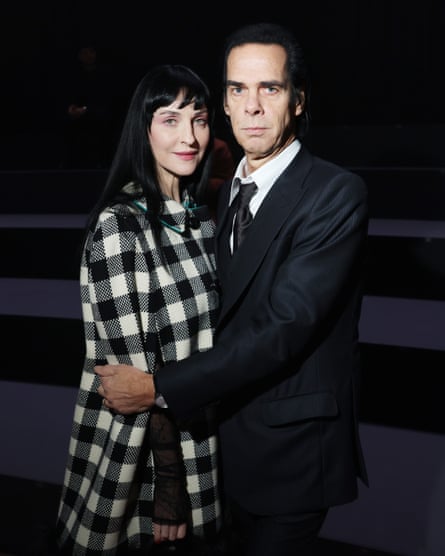
Susie and Nick Cave at Milan fashion week in 2023. Photograph: Victor Boyko/Getty Images for Gucci
Did his experience of bereavement help after Jethro died? “Yes. It really helped, because I knew I could get through. I’d been through it.” Did he feel cursed? “No. No, I don’t feel cursed, no.” He says it would be wrong to talk publicly about Jethro – he didn’t meet Jethro till he was seven and their relationship was complex; although they became close, it would be disrespectful to his mother, who brought him up. (Cave’s first two children, Luke and Jethro, were born 10 days apart to different women.)
Cave says one way in which he has changed is that he appreciates life more. In the past, he has described learning to live again, refinding happiness, as an act of defiance. But he no longer thinks it’s an appropriate word. “Defiance has a fuck-you element to the world; we’re not going to let it get us down. That sounds a little too heroic now. I’m pretty simple-minded about things. It says something to my children who have died that I can enjoy my life now. It’s what they would want. I think it’s a softer relationship we have to the world now.”
Rather than a two-fingered salute to fate, it goes back to culpability and his Christian (if questioning) faith. “Look, this is extremely difficult to talk about, but one of the things that used to really worry me is that Arthur, wherever he may be, if he is somewhere, somehow understands what his parents are going through because of something he did, and that his condition of culpability is not dissimilar to mine. And I think that’s the reason behind a lot of what I do. It’s to say it’s OK. I mean it’s not OK, but we’re OK. We’re OK. I think Susie feels that, too.”
He stresses that he is not just talking about his personal tragedies. “What’s it saying to all those who’ve passed away in their multitudes if we lead lives where we’re just pathologically pissed off at the world? What does it say to those who have left the world to be in a perpetual state of misery and fury and depression and cynicism towards the world? What legacy are they leaving if that’s how we manifest the passing of that person?”
He thinks people sometimes misunderstand what he is saying about loss. It’s not that there is more joy in his world than there was – far from it. But when it comes, it tends to be more intense. “Joy is something that leaps unexpectedly and shockingly out of an understanding of loss and suffering. That’s how Susie and I are. That’s in no way saying we’re not affected, or we’ve somehow gotten over it, or we’ve had closure or even acceptance. I think closure is a dumb thing. Even acceptance is, like: ‘Just give it a few years and life goes back to how it was.’ It doesn’t happen. You’re fundamentally changed. Your very chemistry is changed. And when you’re put back together again, you’re a different person. The world feels more meaningful.”
He knows plenty of people disagree with him. “I get people, mothers particularly, occasionally saying: ‘How dare you suggest there is joy involved in any of this?’ People are so angry, and they have every right to be enraged by the fucked-up cosmic mischief that goes on, and it’s deeply unfair. But it’s not personal. It feels like it is, but it’s just the vicissitudes of life.”
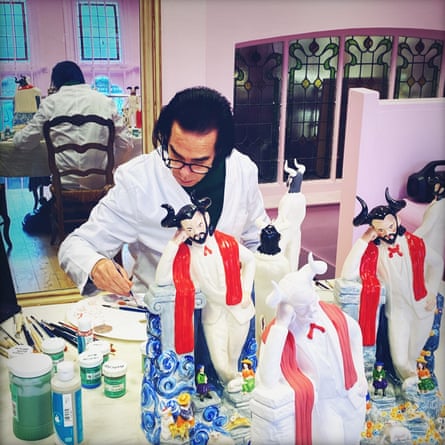
At work. Photograph: courtesy of Liv & Dom
Cave feels he is misunderstood in another way, after saying recently that he has always been “temperamentally” conservative and attacking the “self-righteous belief” and “lack of humility” of woke culture. This has led some to assume he is supping with the “alt-right”, which couldn’t be further from the truth.
“Conservatism is a difficult word to talk about in Britain, because people immediately think of the Tories. But I do think small-C conservatism is someone who has a fundamental understanding of loss, an understanding that to pull something down is easy, to build it back up again is extremely difficult. There is an innate need in us to rip shit down, and I’m personally more cautious in that respect without it being a whole political ideology that surrounds me.”
Is he a Tory? “I’m not a Tory, no.” Has he ever been? “No. No, I’ve never voted Tory.” And is he really anti-woke? “The concept that there are problems with the world we need to address, such as social justice; I’m totally down with that. However, I don’t agree with the methods that are used in order to reach this goal – shutting down people, cancelling people. There’s a lack of mercy, a lack of forgiveness. These go against what I fundamentally believe on a spiritual level, as much as anything. So it’s a tricky one. The problem with the right taking hold of this word is that it’s made the discussion impossible to have without having to join a whole load of nutjobs who have their problem with it.”
He hates dogma, whether religious or political. His work has always embraced uncertainty. “People don’t like me to say this, but I do feel it’s in my nature to constantly be redressing the balance of my own ideas about things. My mother was exactly the same – she always saw the other side. It was incredibly frustrating. You’d be angry about something and she’d go: ‘Yes darling, but …’”
Like his mother, he has never shied away from the trickiest “buts”. When he talks about his appalling loss, he also knows he has been lucky. Not only has he been able to express his grief in his work, but it has also fed his creativity. Even at its bleakest, he has found it cathartic. “Making art is in itself the great expression of joy and optimism, in my view. That’s why we need it. Music, art, reminds us of our fundamental capacity to create beautiful things out of the fuckeries of life. Even when I’m making The Devil Kills His First Child, I’m not depressed, I’m like: ‘Wow! Look at the head!’ It’s a joyful occupation, no matter what. And when I’m singing a very sad lyric, it doesn’t mean I’m sad inside.”
The forthcoming Bad Seeds album is the first thing he has created since Arthur’s death that isn’t “set through a lens of loss”. He is funny when talking about his work – so angsty and uncertain early in the process, almost messianic by the end. “The new album is really good. It’s really strong. Great songs,” he says.
Similarly with The Devil – A Life. He has got over the doubts and now he is buzzing with self-belief. Is he nervous about the exhibition? “No, I’m excited. I think the ceramics are really good and really strange.” But he feels unusually protective towards his figurines and the story that they tell. “These guys feel extraordinarily vulnerable. They are vulnerable little things, and they are saying something deeply personal.”
Nick Cave: The Devil – A Life is at Xavier Hufkens in Brussels from 5 April to 11 May
